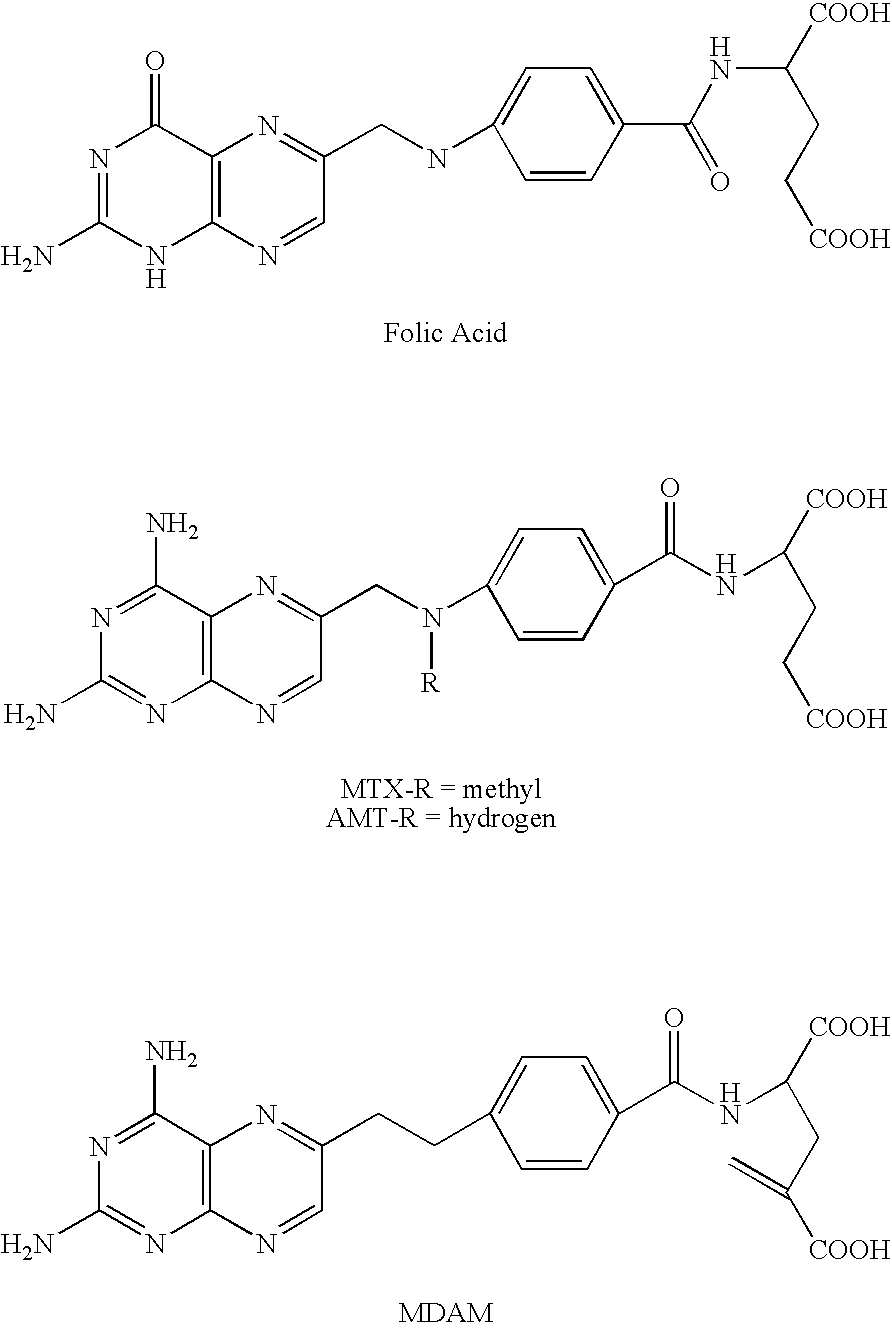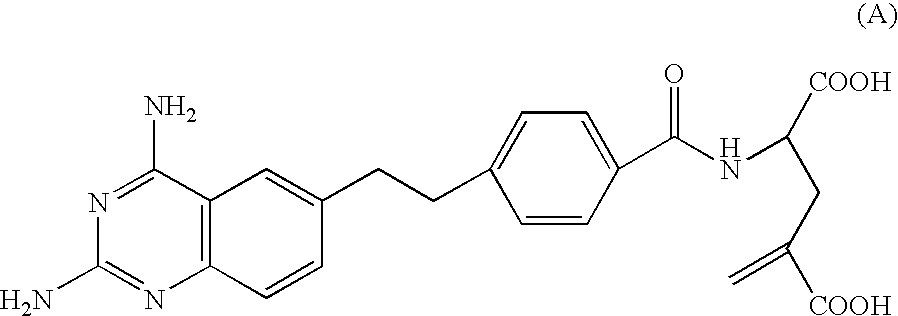Process for synthesizing 6-quinazolinyl-ethyl-benzoyl and related antifolates
a technology of ethylbenzoyl and ethylbenzoyl, which is applied in the field of synthesizing 6quinazolinylethylbenzoyl and related antifolates, can solve the problems of inefficiency and commercial viability, and achieve the effect of efficient and economical process
- Summary
- Abstract
- Description
- Claims
- Application Information
AI Technical Summary
Benefits of technology
Problems solved by technology
Method used
Image
Examples
example 1
[0047]
[0048]To an ice-water bath cooled solution of 25% sodium methoxide in methanol (216 ml) and absolute ethanol (800 ml) was added guanidine hydrochloride (96 g, 1 mole). The cloudy mixture was stirred with the ice-water bath for 30 minutes and filtered through Celite. The filtrate was transferred into a 2-liter flask and 2-amino-5-nitro benzonitrile (163 g, 1 mole) was added. The mixture was heated to reflux for 5 hours and allowed to stand at room temperature overnight. The resulting orange brown solid was filtered and boiled with acetic acid (2 L) for 15 minutes. The mixture was filtered while hot and the filtrate was allowed to cool to room temperature overnight. The resulting yellow crystals were filtered, washed thoroughly with ethanol and dried to obtain the first crop of the product as an orange brown solid (92.2 g). The residue from the first acetic acid extraction was extracted one more time by boiling the residue in the mother liquid of the first crop. The mixture was ...
example 2
[0049]
[0050]2,4-diamino-6-nitro quinazoline (40 g, 195 mmole), DMF (320 ml), acetic acid (3.2 ml) and 10% Pd / C (4.0 g) were charged into a 1-liter flask for Parr Apparatus and hydrogenated under 40 psi overnight. The catalyst was filtered off through Celite. The filtrate was concentrated to about 40 ml under reduced pressure and ethyl acetate (900 ml) was added to the concentrated residue. The resulting suspension was stirred for 30 minutes. The yellow-greenish solid was filtered, washed with fresh ethyl acetate and dried in vacuo to yield 30.2 grams of the product. 1HNMR (DMSO-d6) δ5: 4.82 (bs, 2H), 6.08 (bs, 2H), 6.89–7.97 (m, 3H) 7.11 (bs, 2H).
example 3
[0051]
[0052]A cold solution of NaNO2 (23 g, 333 mmole) in water (170 ml) was added to an ice-water bath pre-cooled solution of 2,4,6-triamino quinazoline (57 g, 325 mmole) in 2M HCl (660 ml). The mixture was stirred until it was clear and then added to a warm (50–55° C.) mixture of CuSO4.5H2O (82 g, 328 mmole) in water (250 ml) and KCN (106.5 g, 1635 mmole) in water (190 ml), which were stirred in a 5-liter four-necked flask equipped with a mechanical stirrer, additional funnel, condenser, nitrogen inlet and gas outlet leading into NaOH solution. The reaction mixture was stirred at 52–55° C. for 30 minutes and then allowed to cool to ˜35° C. Concentrated NH4OH (325 ml) was added and the mixture was stirred at room temperature for 1 hour. The precipitates were filtered and boiled in 15% acetic acid (875 ml) for 5 minutes. The suspension was filtered while hot. The warm filtrate was diluted with 2-methoxy ethanol (740 ml) and concentrated NH4OH (265 ml). The resulting suspension was a...
PUM
| Property | Measurement | Unit |
|---|---|---|
| temperature | aaaaa | aaaaa |
| temperature | aaaaa | aaaaa |
| temperature | aaaaa | aaaaa |
Abstract
Description
Claims
Application Information
 Login to View More
Login to View More - R&D
- Intellectual Property
- Life Sciences
- Materials
- Tech Scout
- Unparalleled Data Quality
- Higher Quality Content
- 60% Fewer Hallucinations
Browse by: Latest US Patents, China's latest patents, Technical Efficacy Thesaurus, Application Domain, Technology Topic, Popular Technical Reports.
© 2025 PatSnap. All rights reserved.Legal|Privacy policy|Modern Slavery Act Transparency Statement|Sitemap|About US| Contact US: help@patsnap.com



